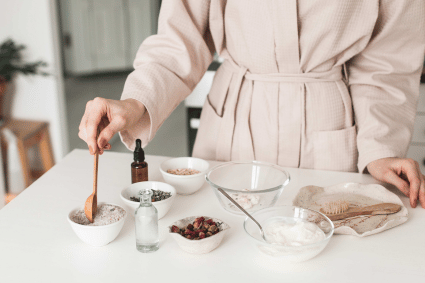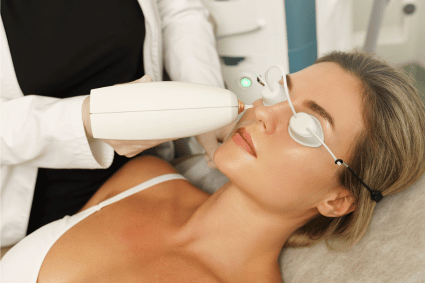
Dark Circles: Causes and Symptoms
Dark circles under the eyes are a frequent cosmetic concern that can affect people of all ages. Their cause can be attributed to a variety of reasons, ranging from genetic predisposition, lifestyle and environmental factors.
A primary contributor to dark circles is genetics; people with a history of dark circles in their family are more likely to experience them. This hereditary factor can lead to people having thinner skin under the eyes. Resulting in the blood vessels being more visible and results in a darker appearance.
Aging is another significant factor that contributes to dark circles. As we age our skin loses collagen and elasticity, leading to a sagging effect and the appearance of eye bags. This natural aging process can increase the visibility of dark circles, creating a tired or worn appearance.
Your lifestyle also has a role in the development of dark circles. Poor sleep habits can lead to a pale complexion, thereby intensifying the contrast between the surrounding skin and dark circles under the eyes. Adults generally require about 7-9 hours of sleep each night. Insufficient sleep not only accentuates the appearance of dark circles but can also contribute to more serious health issues.
Paying attention to your diet also has a role to play in preventing the appearance of dark circles. By consuming foods rich in vitamins C and E, zinc, and omega-3 fatty acids you can help nourish the skin. Fruits and vegetables that are high in antioxidants can combat oxidative stress and improve circulation, thereby reducing dark circles. Adding leafy greens, citrus fruits, nuts, and fatty fish to your meals for optimal benefits.
Stress and consuming excessive alcohol or smoking can bring about dark circles. These habits can cause blood vessels to dilate, contributing to the accumulation of waste products beneath the eyes.
Another factor is dehydration, failure to hydrate sufficiently can cause the skin under the eyes to become dull and less plump, further highlighting these dark areas. Drinking adequate water throughout the day helps maintain skin elasticity and can diminish the appearance of dark circles. Aim for at least eight glasses of water daily, as hydration aids in detoxification and improves overall skin health.
Certain medical conditions, including allergies, eczema, or sinus problems, can also manifest through symptoms like puffiness or swelling, compounding the appearance of dark circles.
It is crucial for for people to recognize the multifaceted nature of dark circles, which may vary in presentation and severity from one individual to another. Understanding these various factors is the first step toward identifying effective treatments and solutions.

Treatments: Under Eye Creams and Serums
Dark circles, puffiness, wrinkles and fine lines are common concerns for many people, prompting interest in effective treatments aimed specifically at the delicate under-eye area.
Under eye creams and serums have gained popularity as potent solutions in addressing these issues, thanks to their targeted formulations designed to deliver active ingredients directly where they are needed most.
There are numerous products available, caffeinated creams often stand out for their ability to reduce puffiness remarkably. Caffeine acts as a vasoconstrictor, which helps to tighten blood vessels and reduce swelling.
Products like The Ordinary Caffeine Solution 5% + EGCG have received favorable reviews, with users noting enhanced firmness and a notable reduction of dark circles after consistent use.
Hyaluronic acid-based serums also merit attention due to their hydrating properties. This ingredient retains moisture, making the skin appear plumper and smoother.
Products such as Neutrogena Hydro Boost Gel-Cream are celebrated for their lightweight texture and effectiveness in minimizing fine lines while providing the hydration essential for maintaining skin elasticity.
Peptides further contribute to the fight against under-eye dark circles. Peptides promote collagen production, which is crucial for maintaining skin structure and reducing the appearance of wrinkles. One exemplary product is Olay Eyes Brightening Eye Cream, which has a blend of peptide complexes that enhance skin texture and brightness.
When choosing under eye cream or serum, it is important to consider your skin type and concerns. For dry skin, thicker creams may be beneficial, while oily skin types might prefer lightweight gels. You should also pay attention to the product’s ingredient list, opting for those that specifically target the concern that you have. By understanding the various benefits of different products you can make informed decisions as to what best suites your skincare routine.

Home Remedies
There are several natural home remedies that can help to in alleviate dark circles. Cold compresses, such as chilled spoons or a cloth soaked in cold water, can constrict blood vessels and reduce puffiness.
Tea bags, especially those infused with chamomile or green tea, are rich in antioxidants and can provide anti-inflammatory effects. Simply place cooled tea bags over the eyes for about 10-15 minutes for noticeable improvement.
Using essential oils, such as rose or lavender oil, may also help due to their soothing properties. Make sure to dilute essential oils with a carrier oil before applying to avoid skin irritation.
By including these home remedies and making healthy lifestyle choices you can work towards reducing dark circles and improving overall skin appearance.

Professional Treatments: What Are Your Options?
Dark circles, eye bags, wrinkles and fine lines can be considerably reduced through a range of professional treatments. These options are designed to address the underlying causes of pigmentation and puffiness, offering people effective solutions beyond home remedies and treatments.
Among the most common professional treatments are dermal fillers, laser therapy and chemical peels. Each treatment has its own set of benefits, costs, expected results, and recovery times which are essential for potential patients to consider.
Dermal fillers are often used to restore volume under the eyes, where age-related thinning can result in dark circles. Dermal fillers can effectively smooth the skin and diminish shadowing. Typically, results are visible immediately with the effects lasting anywhere from six months to two years, depending on the type of filler used. The average cost for dermal fillers ranges from $600 to $1,500 per syringe, this depends on the practitioner and geographical location.
Laser therapy is another popular option that uses focused light to directly target pigmentation and fine lines. This treatment can enhance skin texture and reduce the appearance of dark circles. Generally, multiple sessions are required to achieve optimal results. Notably visible improvements often occurring within a few months post-treatment. Recovery time can vary, but redness and swelling usually subside within a week. The cost for laser therapy treatments typically varies between $1,000 and $3,000, depending on the type of laser used and the number of sessions needed.
Chemical peels are also very effective in revitalizing the under-eye area by exfoliating the skin and promoting cell turnover. This can help to lighten pigmentation and improve overall skin tone. Chemical peel treatments range from mild to deep, with recovery times varying accordingly. The cost usually lies between $150 and $600 per session, depending on the depth of the peel and the practitioner’s expertise.
Should you be considering professional treatments, it is vital to assess personal needs and consult a qualified practitioner. They can then determine whether a specific treatment is necessary based on individual circumstances. A qualified professional can guide you through the potential outcomes and help set realistic expectations on each treatments impact on reducing dark circles, wrinkles and lines.
Product Recommendations
The Ordinary Caffeine Solution 5% + EGCG
Neutrogena Hydro Boost Gel-Cream
Olay Eyes Brightening Eye Cream
Lightweight Eye Cream With Vitamin C
Day Wear Eye Cooling Anti-Oxidant Moisture Gel Cream
Disclosure: This post may contain sponsored links, www.lookladies receive a small commission if you decide to make a purchase through our link, this adds no extra cost to you purchase. This commission helps to fund the running and upkeep of this website. Many thanks for your support, the Look Ladies team.
